In this article
The page's title should always be the Snap's name. For example, File Reader.
Use this Snap to commit changes to a shared library document/file that is in checked out state. Ensure that you use the same account that was used to check out the file/document.
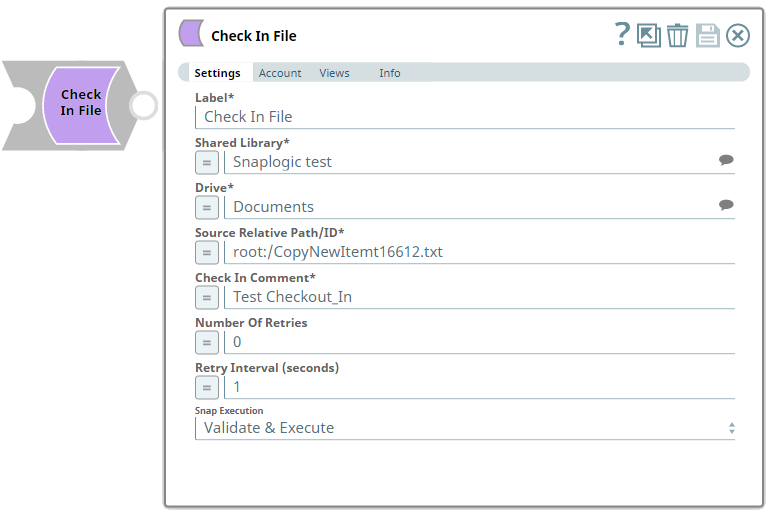
Provide a functional overview of the Snap. Do not mention anything about the Snap's internal technology or techniques. The user should be able to understand what the Snap. Include a screenshot of a well-configured Snap 600px.
List all prerequisites for using the Snap as a bullet list. Use direct sentences. For example, in case of a Write-type Snap a prerequisite would be that the user must have write access. Include links to external official documentation, if required. Use "None." if there no prerequisites.
Works in Ultra Pipelines.
None.
List all Snap-specific limitations as a bullet list. Limitations can be imposed by the Snap's development environment and also by the endpoint's API. List both. Use direct sentences. Include links to external official documentation, if required. Use "None.: if there are no limitations.
Snaps in the Microsoft OneDrive Snap Pack have an in-built retry mechanism for failing connections and requests; but, a high volume of requests from a client might reach the throttling threshold. In such scenarios, the Microsoft Graph limits further requests from that client for a period of time and returns an HTTP status code 429 (Too many requests), thereby causing the requests to fail. Hence, we recommend you to keep a check on the number of requests emanating from your client instance.
Type of view: Document/Binary/Both. Get number of views from the Views tab in the Snap. List at least three compatible Snaps in each category. Provide a brief of the input/output required. If the input/output is optional then preface the description with "Optional." For example, "Transaction data complying with the Orderful schema as a JSON document."
| Input/Output | Type of View | Number of Views | Examples of Upstream and Downstream Snaps | Description |
|---|---|---|---|---|
| Input | Document |
|
| A document containing the details of the checked out file to check in. |
| Output | Document |
|
| A document containing the result of the check in operation. |
| Parameter Name | Data Type | Description | Default Value | Example | |
|---|---|---|---|---|---|
| Label | String | Check In File | Check In File | ||
| Shared Library | String/Expression/Suggestion | Required. Select the Shared Library where the checked out file exists, from the list of suggestions provided. | N/A | My Library | |
| Drive | String/Expression/Suggestion | Required. Select the Drive where the checked out file exists, from the list of suggestions provided. | N/A | Documents | |
| Source Relative Path/ID | String/Expression | Required. Enter the relative path for the file to be checked in, beginning with root:/. Alternatively, pass the item ID in this field.
| root:/ | /Pictures/Tour1/Image01.png | |
| Check In Comment | String/Expression | Required. Enter the summary of changes made to the checked out file. | N/A | Photo-edits for sharper images. | |
| Number Of Retries | String/Expression | Specify an integer value to set the maximum number of reconnection attempts that the Snap must perform, in case of connection failure or timeout. | 0 | 3 | |
| Retry Interval (Seconds) | String/Expression | Enter, in seconds, the duration for which the Snap must wait between two reconnection attempts, until the number of retries is reached. | 1 | 2 | |
| Snap Execution | Drop-down list | Select one of the three following modes in which the Snap executes:
| Execute only | Validate & Execute |
You can get information for this section from the Snap's source code, typically the Messages.java file in GitHub. Ask the developer to access this file. Do not use "Please" in the Reason or Resolution. If there is "Please" in the error message then contact the developer to have it removed as needed.
| Error | Reason | Resolution |
|---|---|---|
| Error while Checking in a file with relativePath : root:/CopyNewItemt1661.txt, Reason: 404 : Not Found : The resource could not be found. | The specified file is not available in the Drive to check in. | Ensure that the DriveItem/file you want to check in is available in the Drive (with exactly the same name). |
| Error while Check in a file with relativePath : root:/CopyNewItemt16612.txt, Reason: 400 : Bad Request : The file is not checked out. | The specified file must be in checked out state. | Ensure that the DriveItem/file has been duly checked out (and updated) before attempting to check in the file. |
Include functional examples to demonstrate the various functionalities of the Snap. Examples are different from Use Cases. An example should focus on the Snap in question. Use first-person plural references. Start with the Pipeline's objective and then describe how you would go about using the Snap to fulfill this objective. Include all SLPs in the Downloads section. Use videos if a Snap's configuration is complex and difficult to capture using screenshots. Ensure that the screenshots are optically similar, the size of the text in the screenshots should be readable and similar in size. Max image size 1000 px. Screenshots must include: Pipeline, Snap Configs, Inputs, and Outputs. Refer to ELT Snaps for an instance.

This Pipeline demonstrates how you can use the Snaps in the Microsoft OneDrive Snap Pack to upload, check out, check in and download files in an authorized Share Library location. It assumes that you have configured your Azure application and the Snap accounts already. The Pipeline uses the following parameters.

First, we upload a file to a Shared Library location using File Reader Snap, locate it and check out for editing. Then we check in the updated file and download it.
| File Reader Snap |
|---|
|
Output |
 |
After reading the file from the location provided, we upload the file into a Shared Library (location for Shared files within OneDrive). We configure the Snap to replace existing file with this file, if their file names are same.
| Upload File Snap |
|---|
|
| Output |
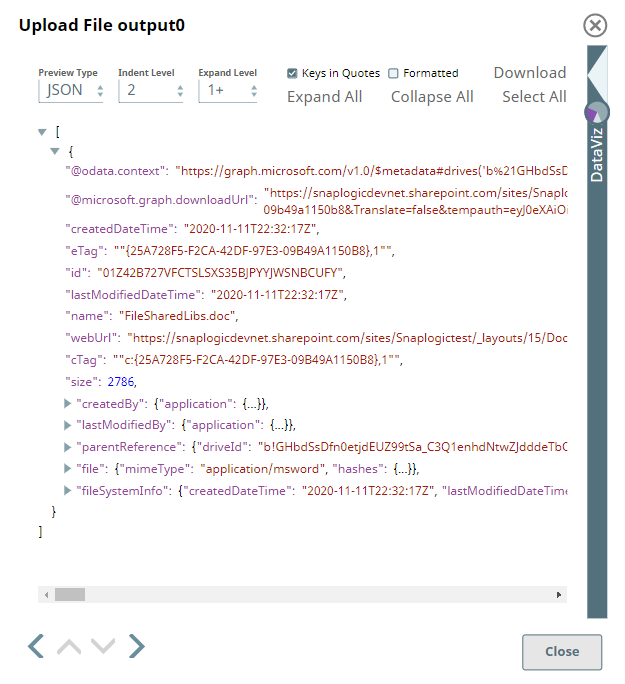 |
Now that the file is available in the shared location, let us check out the file for editing. To check out the file, we need to capture the file name. We use a Mapper Snap to extract the file name from the Upload file output view.
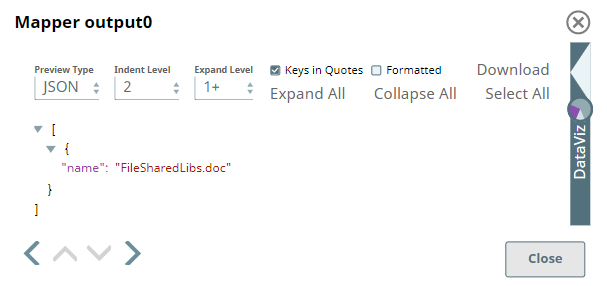
We pass the extracted file name along with its location (in shared library) using an expression in the Source Relative Path/ID field, for checking out the file.
| Check Out File Snap | Output |
|---|---|
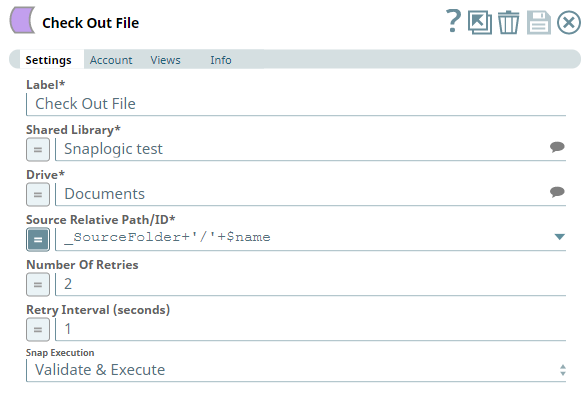 | 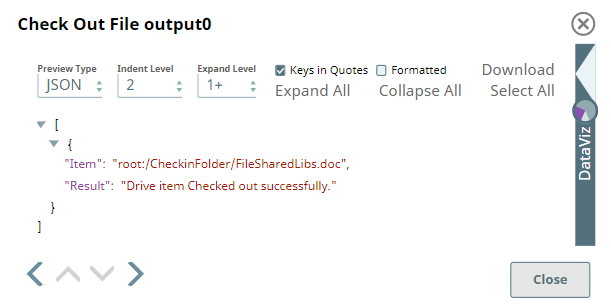 |
The Check Out File Snap provides the name of the checked out file in the $Item field and the result of the check out operation. We use a Mapper Snap again to retrieve this value in $Item and pass it to the Check In File Snap — to check in the same file after it is updated.

In the Check In File Snap, we provide the file details in the Source Relative Path/ID field and an editing comment in the Check In Comment field. This Snap outputs a similar information - $Item and Result of the check in operation.
| Check In File Snap | Output |
|---|---|
 |  |
Now, we directly pass the value in $Item field of the output to a Download File Snap to download the file. The Snap downloads the file and returns the location where the file is downloaded. In addition to this, the Snap also relays the (original) output from the previous Snap (Check In File Snap).
| Download File Snap |
|---|
|
| Output |
 |
Add a download link to the Pipeline in the the "Download" text above. Explain the Pipeline/Snap configuration in detail if a complex enough example has been used. Ensure that the functionality you are trying to illustrate is captured correctly. Include caveats as appropriate. To insert link: Press Ctrl + K --> Files --> Select the SLP file corresponding to the example.
|

Edit the Excerpt Include macro below to link to the Snap Pack page for this Snap page. Ensure that the heading Snap Pack History is not within the Snap Pack's history Excerpt.
Provide links to the endpoint's official documentation, any relevant or related internal documentation, and any other links you have referred to on this page. Care should be taken when referencing external sites/documentation that it is an official site/documentation. Do not refer to forums such as stackoverflow.